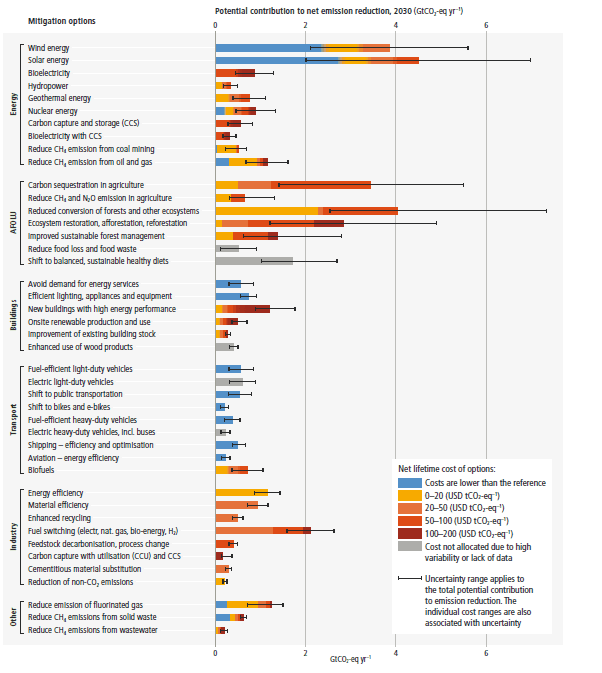Figure: SPM.7
Figure SPM.7: Overview of mitigation options and their estimated ranges of costs and potentials in 2030. Costs shown are net lifetime costs of avoided greenhouse gas emissions. Costs are calculated relative to a reference technology. The assessments per sector were carried out using a common methodology, including definition of potentials, target year, reference scenarios, and cost definitions. The mitigation potential (shown in the horizontal axis) is the quantity of net greenhouse gas emission reductions that can be achieved by a given mitigation option relative to a specified emission baseline. Net greenhouse gas emission reductions are the sum of reduced emissions and/or enhanced sinks. The baseline used consists of current policy (~ 2019) reference scenarios from the AR6 scenarios database (25/75 percentile values). The assessment relies on approximately 175 underlying sources, that together give a fair representation of emission reduction potentials across all regions. The mitigation potentials are assessed independently for each option and are not necessarily additive. {12.2.1, 12.2.2}
The length of the solid bars represents the mitigation potential of an option. The error bars display the full ranges of the estimates for the total mitigation potentials. Sources of uncertainty for the cost estimates include assumptions on the rate of technological advancement, regional differences, and economies of scale, among others. Those uncertainties are not displayed in the figure.
Potentials are broken down into cost categories, indicated by different colours (see legend). Only discounted lifetime monetary costs are considered. Where a gradual colour transition is shown, the breakdown of the potential into cost categories is not well known or depends heavily on factors such as geographical location, resource availability, and regional circumstances, and the colours indicate the range of estimates. Costs were taken directly from the underlying studies (mostly in the period 2015-2020) or recent datasets. No correction for inflation was applied, given the wide cost ranges used. The cost of the reference technologies were also taken from the underlying studies and recent datasets. Cost reductions through technological learning are taken into account (FOOTNOTE XY).
When interpreting this figure, the following should be taken into account:
- The mitigation potential is uncertain, as it will depend on the reference technology (and emissions) being displaced, the rate of new technology adoption, and several other factors.
- Cost and mitigation potential estimates were extrapolated from available sectoral studies. Actual costs and potentials would vary by place, context and time.
- Beyond 2030, the relative importance of the assessed mitigation options is expected to change, in particular while pursuing long-term mitigation goals, recognising also that the emphasis for particular options will vary across regions (for specific mitigation options see sections C4.1, C5.2, C7.3, C8.3 and C9.1).
- Different options have different feasibilities beyond the cost aspects, which are not reflected in the figure (cf. section E.1).
- The potentials in the cost range 100 to 200 USD tCO2-eq-1 may be underestimated for some options.
- Costs for accommodating the integration of variable renewable energy sources in electricity systems are expected to be modest until 2030, and are not included because of complexities in attributing such costs to individual technology options.
- Cost range categories are ordered from low to high. This order does not imply any sequence of implementation.
- Externalities are not taken into account.
{12.2, Table 12.3, 6.4, Table 7.3, Supplementary Material Table 9.2, Supplementary Material Table 9.3, 10.6, 11.4, Fig 11.13, Supplementary Material 12.A.2.3}
FOOTNOTE XY: For nuclear energy, modelled costs for long-term storage of radio-active waste are included.
